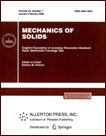 | | Mechanics of Solids
A Journal of Russian Academy of Sciences | | Founded
in January 1966
Issued 6 times a year
Print ISSN 0025-6544
Online ISSN 1934-7936 |
Archive of Issues
| Total articles in the database: | | 13288 |
| In Russian (Èçâ. ÐÀÍ. ÌÒÒ): | | 8164
|
| In English (Mech. Solids): | | 5124 |
|
| << Previous article | Volume 59, Issue 8 / 2024 | Next article >> |
| Ning Wang, Yongjuan Wang, Cheng Xu, Lixia Fan, and Jun Xue, "Analyses of Crack Propagation under Thermo-Mechanical Coupling Conditions in Typical Small-Caliber Gun Barrels," Mech. Solids. 59 (8), 4051-4065 (2024) |
| Year |
2024 |
Volume |
59 |
Number |
8 |
Pages |
4051-4065 |
| DOI |
10.1134/S0025654424605445 |
| Title |
Analyses of Crack Propagation under Thermo-Mechanical Coupling Conditions in Typical Small-Caliber Gun Barrels |
| Author(s) |
Ning Wang (School of Mechanical Engineering, Nanjing University of Science and Technology, Nanjing, 210094 China)
Yongjuan Wang (School of Mechanical Engineering, Nanjing University of Science and Technology, Nanjing, 210094 China, 18936030961@189.cn)
Cheng Xu (School of Mechanical Engineering, Nanjing University of Science and Technology, Nanjing, 210094 China)
Lixia Fan (School of Mechanical Engineering, Nanjing University of Science and Technology, Nanjing, 210094 China)
Jun Xue (No. 208 Research Institute of China Ordnance Industries, Beijing, 102202 China) |
| Abstract |
This study investigates the propagation pattern of barrel matrix cracks by analyzing the morphology and dimensions of radial cracks in barrels at different stages of life. A finite element numerical
model was established for a chrome-plated barrel with an internal radial crack under thermal load, gas
pressure load, and coupled load effects, capturing the stress response at the crack tip within the barrel
bore under cracked conditions. Incorporating the results of crack morphology analysis, a relationship
between the internal crack size and the number of projectiles fired was established, and an empirical
model for crack propagation was developed. The critical crack size and the crack expansion life of the
barrel at the dangerous cross-section were analyzed and compared. The results indicate that the most
hazardous location of the barrel is at the rear part, which is subjected to high gas loads and has a thinner wall thickness. When the maximum chamber pressure exceeds 450 MPa, the theoretical safe service life of the barrel has decreased to a level comparable to the life required to maintain ballistic accuracy, at which point the safety of the barrel can no longer be assured. |
| Keywords |
fracture mechanics, gun barrel, crack propagation, stress intensity factor, fatigue life analyses of crack propagation under thermo-mechanical |
| Received |
19 September 2024 | Revised |
07 November 2024 | Accepted |
04 December 2024 |
| Link to Fulltext |
|
| << Previous article | Volume 59, Issue 8 / 2024 | Next article >> |
|
 If you find a misprint on a webpage, please help us correct it promptly - just highlight and press Ctrl+Enter If you find a misprint on a webpage, please help us correct it promptly - just highlight and press Ctrl+Enter
|
|

 Russian
Russian  English
English